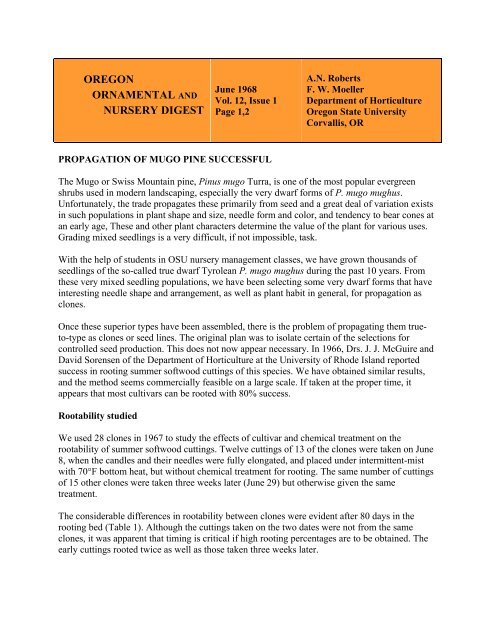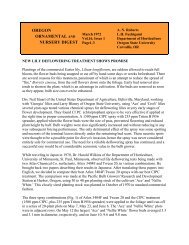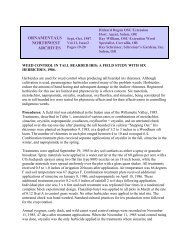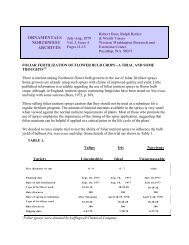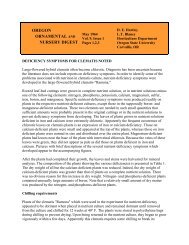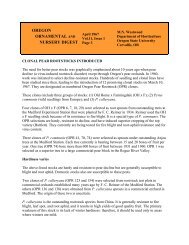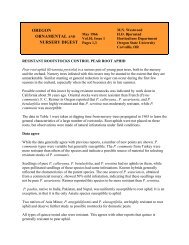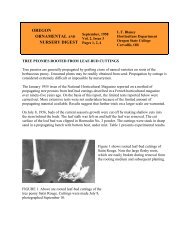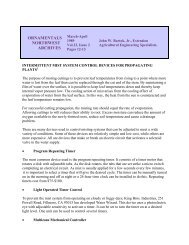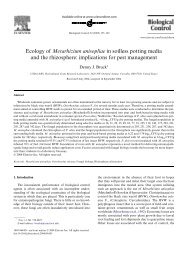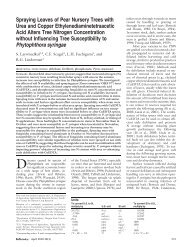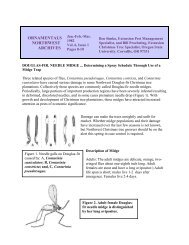Propagation of Mugo Pine Successful, Vol.12, Issue 1
Propagation of Mugo Pine Successful, Vol.12, Issue 1
Propagation of Mugo Pine Successful, Vol.12, Issue 1
You also want an ePaper? Increase the reach of your titles
YUMPU automatically turns print PDFs into web optimized ePapers that Google loves.
OREGON<br />
ORNAMENTAL AND<br />
NURSERY DIGEST<br />
June 1968<br />
Vol. 12, <strong>Issue</strong> 1<br />
Page 1,2<br />
PROPAGATION OF MUGO PINE SUCCESSFUL<br />
A.N. Roberts<br />
F. W. Moeller<br />
Department <strong>of</strong> Horticulture<br />
Oregon State University<br />
Corvallis, OR<br />
The <strong>Mugo</strong> or Swiss Mountain pine, Pinus mugo Turra, is one <strong>of</strong> the most popular evergreen<br />
shrubs used in modern landscaping, especially the very dwarf forms <strong>of</strong> P. mugo mughus.<br />
Unfortunately, the trade propagates these primarily from seed and a great deal <strong>of</strong> variation exists<br />
in such populations in plant shape and size, needle form and color, and tendency to bear cones at<br />
an early age, These and other plant characters determine the value <strong>of</strong> the plant for various uses.<br />
Grading mixed seedlings is a very difficult, if not impossible, task.<br />
With the help <strong>of</strong> students in OSU nursery management classes, we have grown thousands <strong>of</strong><br />
seedlings <strong>of</strong> the so-called true dwarf Tyrolean P. mugo mughus during the past 10 years. From<br />
these very mixed seedling populations, we have been selecting some very dwarf forms that have<br />
interesting needle shape and arrangement, as well as plant habit in general, for propagation as<br />
clones.<br />
Once these superior types have been assembled, there is the problem <strong>of</strong> propagating them trueto-type<br />
as clones or seed lines. The original plan was to isolate certain <strong>of</strong> the selections for<br />
controlled seed production. This does not now appear necessary. In 1966, Drs. J. J. McGuire and<br />
David Sorensen <strong>of</strong> the Department <strong>of</strong> Horticulture at the University <strong>of</strong> Rhode Island reported<br />
success in rooting summer s<strong>of</strong>twood cuttings <strong>of</strong> this species. We have obtained similar results,<br />
and the method seems commercially feasible on a large scale. If taken at the proper time, it<br />
appears that most cultivars can be rooted with 80% success.<br />
Rootability studied<br />
We used 28 clones in 1967 to study the effects <strong>of</strong> cultivar and chemical treatment on the<br />
rootability <strong>of</strong> summer s<strong>of</strong>twood cuttings. Twelve cuttings <strong>of</strong> 13 <strong>of</strong> the clones were taken on June<br />
8, when the candles and their needles were fully elongated, and placed under intermittent-mist<br />
with 70°F bottom heat, but without chemical treatment for rooting. The same number <strong>of</strong> cuttings<br />
<strong>of</strong> 15 other clones were taken three weeks later (June 29) but otherwise given the same<br />
treatment.<br />
The considerable differences in rootability between clones were evident after 80 days in the<br />
rooting bed (Table 1). Although the cuttings taken on the two dates were not from the same<br />
clones, it was apparent that timing is critical if high rooting percentages are to be obtained. The<br />
early cuttings rooted twice as well as those taken three weeks later.
A small experiment to test the importance <strong>of</strong> hormone treatment in rooting s<strong>of</strong>twood cuttings <strong>of</strong><br />
<strong>Mugo</strong> pine was also included in this study. Twelve cuttings <strong>of</strong> each <strong>of</strong> three clones were taken on<br />
June 29 and given a 5-second dip in half or full-strength Jiffy Grow No. 2. The same number <strong>of</strong><br />
cuttings were given no hormone treatment. The cuttings were then given 80 days in the rooting<br />
environment outlined previously. The percentage <strong>of</strong> cuttings rooting is given in Table 2.<br />
It is evident again that certain clones were rooted more easily than others. Although hormone<br />
treatment may improve the rooting <strong>of</strong> some cultivars, it may also be injurious to others,<br />
especially at high concentrations. If taken at the proper time, it appears that most cultivars will<br />
root readily at percentages <strong>of</strong> 50 to 100% (Table 1).<br />
The advantages to the nursery trade <strong>of</strong> being able to market <strong>Mugo</strong> pines <strong>of</strong> predictable size<br />
potential, as well as needle and other plant qualities, are obvious. There is also the possibility <strong>of</strong><br />
propagating selected clones that can be marketed as small Christmas trees, in pots and bearing<br />
cones (Figure 1). The small potted plants <strong>of</strong> OSU 67-19 shown in the picture developed their<br />
cones while in the rooting bench and are in the process <strong>of</strong> making their first year <strong>of</strong> growth from<br />
a cutting. This very dwarf clone was one <strong>of</strong> the few developing cones on the cutting in this<br />
manner, and it makes a most attractive and interesting pot plant.<br />
Table 1. Differences in rootability <strong>of</strong> summer s<strong>of</strong>twood<br />
cuttings <strong>of</strong> representative <strong>Mugo</strong> pine selections<br />
Cuttings taken June 8 Cuttings taken June 29<br />
Clone number Rooting Clone number Rooting<br />
% %<br />
OSU- 1 75 OSU-14 42<br />
OSU- 2 92 OSU-15 25<br />
OSU- 3 92 OSU-16 0<br />
OSU- 4 83 OSU-17 42<br />
OSU- 5 83 OSU-18 0<br />
OSU- 6 100 OSU-19* 67<br />
OSU- 7 67 OSU-20 100<br />
OSU- 8 83 OSU-21 25<br />
OSU- 9 67 OSU-22 75<br />
OSU-10 67 OSU-23 67<br />
OSU-11 50 OSU-24 0<br />
OSU-12 92 OSU-25 8<br />
OSU-13 58 OSU-26 0<br />
Average 78 OSL-27 0<br />
OSU-28 27<br />
Average 32<br />
*Clone in figure 1
Table 2. Influence <strong>of</strong> cultivar and hormone treatment on rooting <strong>of</strong> summer s<strong>of</strong>twood<br />
cuttings <strong>of</strong> <strong>Mugo</strong> pine<br />
Clone<br />
number<br />
No<br />
treatment<br />
Hormone treatment<br />
Half-<br />
Strength<br />
Jiffy<br />
Grow<br />
Full<br />
strength<br />
Jiffy - Grow<br />
Average<br />
% % % %<br />
I 50 25 8 28<br />
II 33 75 33 47<br />
III 83 50 33 55<br />
Average 55 50 25<br />
It is evident again that certain clones were rooted more easily than others. Although hormone<br />
treatment may improve the rooting <strong>of</strong> some cultivars, it may also be injurious to others,<br />
especially at high concentrations. If taken at the proper time, it appears that most cultivars will<br />
root readily at percentages <strong>of</strong> 50 to 100% (Table 1).<br />
The advantages to the nursery trade <strong>of</strong> being able to market <strong>Mugo</strong> pines <strong>of</strong> predictable size<br />
potential, as well as needle and other plant qualities, are obvious. There is also the possibility <strong>of</strong><br />
propagating selected clones that can be marketed as small Christmas trees, in pots and bearing<br />
cones (Figure 1). The small potted plants <strong>of</strong> OSU 67-19 shown in the picture developed their<br />
cones while in the rooting bench and are in the process <strong>of</strong> making their first year <strong>of</strong> growth from<br />
a cutting. This very dwarf clone was one <strong>of</strong> the few developing cones on the cutting in this<br />
manner, and it makes a most attractive and interesting pot plant.<br />
Figure 1. Potted <strong>Mugo</strong> pines <strong>of</strong><br />
OSU selection 67-19 in the<br />
spring following the summer<br />
rooting <strong>of</strong> cuttings. Note<br />
presence <strong>of</strong> cones and<br />
development <strong>of</strong> new growth.<br />
Oregon Ornamental and Nursery Digest was published from 1957 to 1975 by the Agricultural Experiment Station,<br />
Oregon State University, Corvallis.<br />
Pesticide Use - Due to constantly changing laws and regulations, no liability for the suggested use <strong>of</strong> chemicals in<br />
this reprint is assumed. Pesticides should be applied according to label directions on the pesticide container.
Permission to Reprint material appearing in the Oregon Ornamental and Nursery Digest is granted with the request<br />
that you credit the source: Oregon Ornamental and Nursery Digest, date, volume, issue, page numbers. Do not<br />
excerpt or reprint in such a manner as to imply the author's endorsement or criticism <strong>of</strong> a product or concept.<br />
Nondiscrimination - The information in the Oregon Ornamental and Nursery Digest is provided with the<br />
understanding that no discrimination is intended and that listing <strong>of</strong> commercial products implies no endorsement by<br />
the authors. Criticism <strong>of</strong> products or equipment is neither intended nor implied.


